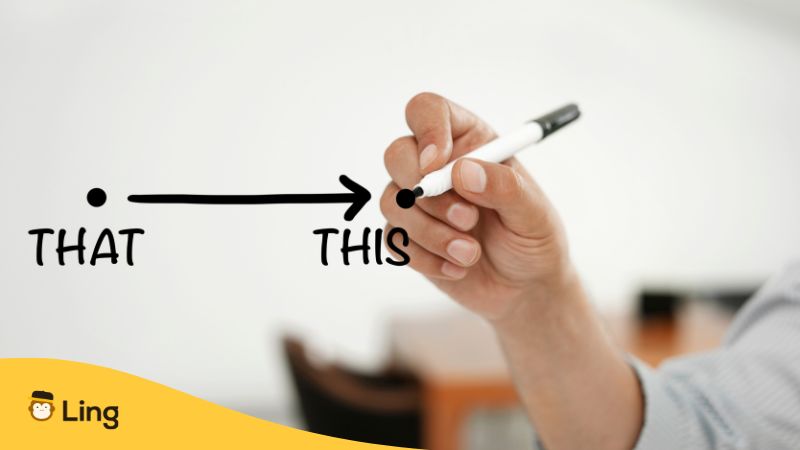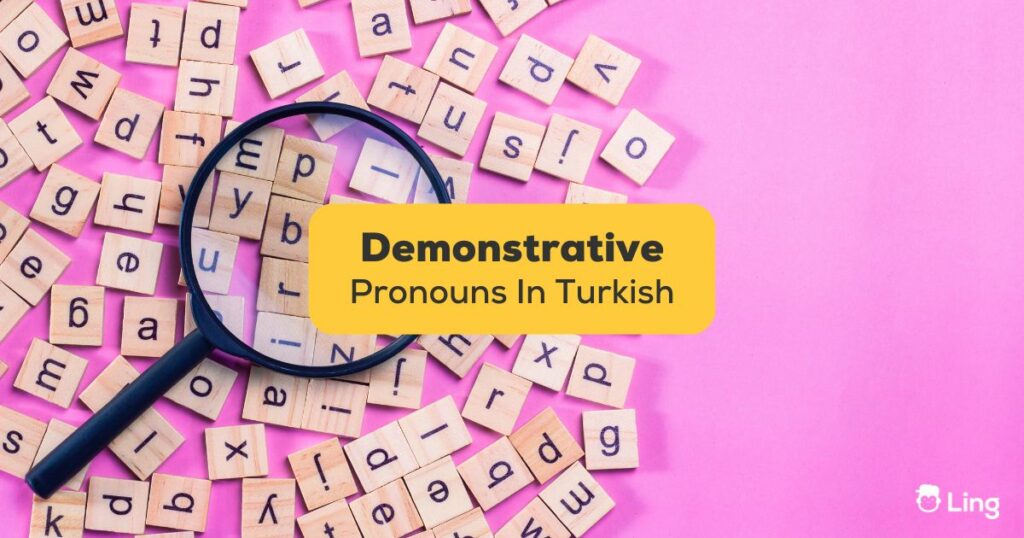I know that the most challenging part of learning the Turkish language is grammar because suffixes make everything more complicated than it actually is. However, never fear! On Ling’s Turkish blog, I try to explain Turkish grammar topics in a simple way for you. And today’s topic is demonstrative pronouns in Turkish!
By the way, if you haven’t read my other blog post, in which I explain all types of Turkish pronouns, make sure you read it before this one!
Table of Contents
What Are The Main Demonstrative Pronouns In Turkish?
Turkish has three main demonstrative pronouns, each corresponding to a specific level of distance. The primary demonstrative pronouns in Turkish are:
- Bu – this (near the speaker)
- Şu – that (near the listener)
- O – that (far from both speaker and listener)
These pronouns indicate proximity and function as subject, object, or possessive pronouns, depending on the context and suffixes they get.
What Are Demonstrative Pronouns In Turkish?
Demonstrative pronouns are pronouns that take the place of nouns by demonstrating. Here is the list of all the demonstrative pronouns in Turkish with example sentences. Though not all of them are commonly used, it’s better to know them just in case:
| English | Turkish | Example Sentence (EN) | Example Sentence (TR) |
|---|---|---|---|
| This | Bu | Who did this? | Bunu kim yaptı? |
| That | Şu | What’s wrong with that? | Şunda ne var? |
| That | O | What’s wrong with that? | Benim kitabım o değil. |
| These | Bunlar | These belong to you. | Bunlar size ait. |
| Those | Şunlar | This place isn’t bad, either. | Şunlar da sizin olsun. |
| Them | Onlar | Who are they left to? | Onlar kime kaldı? |
| The other one | Öteki | Give me the other one. | Ötekini bana ver. |
| This one | Beriki | You can keep this one. | Beriki sende kalsın. |
| Here | Bura, burası | That’s not my book. | Bura bana pek yabancı gelmedi. |
| There (closer) | Şura, şurası | How about there? | Şurası nasıl? |
| There (further) | Ora, orası | This place didn’t seem foreign to me. | Ora daha iyi. |
| It’s better there. | Burası | This place isn’t bad either. | Burası da fena değil. |
| There (further) | Orası | It is so far. | Orası çok uzak. |
| This kind of thing | Böylesi | This kind of thing makes people uncomfortable. | Böylesi, insanı rahatsız eder. |
| That kind of thing | Şöylesi | That is not true. | Şöylesi de doğru olmaz ki. |
| Those kinds of things | Öylelerinden | I always avoid those. | Öylelerinden her zaman kaçarım. |
How To Use Demonstrative Pronouns In Turkish Grammar

In Turkish grammar, demonstrative pronouns are used in a variety of sentence forms and contexts. You’ll see the common usage scenarios and examples for each context below:
As Subject Pronouns
In a sentence, bu, şu, and o can serve as subject pronouns. When the context is obvious, they can be used in place of nouns completely or in conjunction for emphasis.
Examples:
- Bu (this) – Referring to a pencil (near the speaker)
- Şu (that) – Referring to a book (near the listener)
- O (that) – referring to a cat (far from both)
In these examples, the demonstrative pronouns replace the subject of the sentence. For instance, in the first example, instead of saying, “This pencil is expensive,” you can say, “This is expensive.” So, in this case, the demonstrative pronoun “bu (this)” functions as a subject pronoun.
As Object Pronouns
Turkish demonstrative pronouns can be used as object pronouns in sentences without needing additional suffixes, and they can also replace a direct object.
Examples:
- Bunu al. – Take this. (near the speaker)
- Şunu seviyorum. – I love that. (near the listener)
- Onu gördüm. – I saw that. (far from both)
In these examples, the demonstrative pronouns replace the object of the sentence. For example, in the first example, instead of saying, “Take this pencil,” you can say, “Take this.” So, in this case, the demonstrative pronoun “Bunu (this)” functions as an object pronoun.
As Possessive Pronouns
To use demonstrative pronouns as Turkish possessive pronouns, suffixes corresponding to the possessed object’s number and case are added.
Examples:
- Bunun – Of this (near the speaker)
- Şunun – Of that (near the listener)
- Onunla – With that (far from both)
In these examples, the demonstrative pronouns replace the object of the sentence. For example, in the first example, instead of saying, “The color of this pencil is red,” you can say, “The color of this is red.” So, in this case, the demonstrative pronoun “bunun (this)” functions as a possessive pronoun.
How Do You Say “Demonstrative Pronoun” In Turkish?
In Turkish, “demonstrative pronoun” is translated as “işaret zamiri.” These pronouns are used to point out specific items or people. For example, in the sentence “Bu benim kitabım” (This is my book), “bu” is a demonstrative pronoun, or “işaret zamiri,” indicating the book that is near the speaker.
Frequently Asked Questions
1. What are the 7 demonstrative pronouns?
The seven demonstrative pronouns are this, that, these, those, such, none, and neither.
2. What are the Turkish pronouns?
Turkish pronouns include:
Turkish personal pronouns: ben (I), sen (you, singular), o (he/she/it), biz (we), siz (you, plural/formal), onlar (they)
Turkish demonstrative pronouns: bu (this), şu (that – closer), o (that – further)
3. What is the difference between the demonstrative pronouns şu and o in Turkish?
In Turkish, “şu” refers to something closer to the listener but still not very close, while “o” refers to something further away from both the speaker and the listener.
4. Does Turkish have gendered pronouns?
No, Turkish does not have gendered pronouns. The pronoun “o” is used for he, she, and it.
Mastering Turkish Pronouns For Better Conversations
Getting a handle on Turkish demonstrative pronouns can really boost your communication skills. The main ones are “bu” (this) for things close to the speaker, “şu” (that) for things closer to the listener, and “o” (that) for things far from both.
These pronouns help you easily point out and talk about different objects and their locations. Whether you’re using them as subjects or objects or to show possession, knowing how to use “bu,” “şu,” and “o” correctly will make speaking Turkish a lot smoother and more natural.
You may also be interested in:


































































